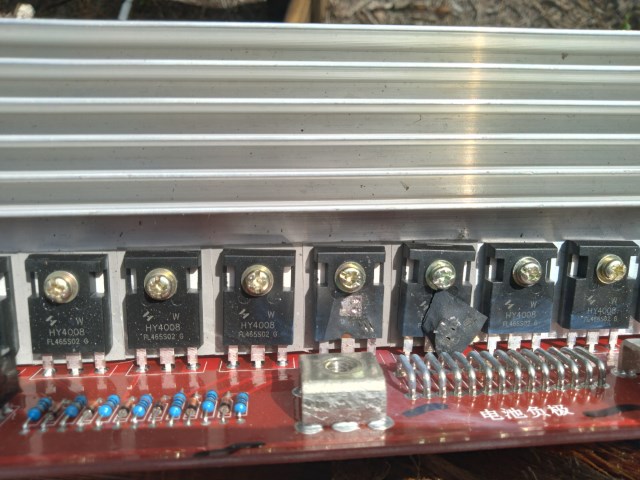Fuses offer cheap circuit protection, but there are some precautions you may need to take.
The H-Bridge locked up on my inverter recently. It blew a fuse. It blew it with a lot of self assurance, too. There was no dilly-dallying. Never mind what an H-Bridge is, but in this case it can handle 1200 amps, so when it locks up, something bad could happen. That’s why there’s a fuse.

Usually, you kind of work your way up to blowing a fuse. The load exceeds the rating, the metal melts and everything stops. When you get over 1200 amps trying to get through a 150 amp fuse, you get a plasma bomb. The blast made a perfectly round hole in the mica window that is there to contain the failure and then it blew the plastic no-finger-pokey cover across the room.
The wife says there was lightning and then stuff didn’t work. So, you think maybe it blew a fuse and you go to replace it because you don’t know you have a locked-up H-bridge. You are careful because all of those capacitors in the inverter make a good pop anytime you put in the fuse. What happens, though, is not a good pop. You get a major arc that burns away part of the fuse holder and part of the fuse. Then the link BLOWS with great vigor, leaving you with black fingers. Being the cautious type, the fingers were on the protective casing of the fuse instead of over the window where the blast originates. The moral of the story is to be careful installing a new fuse.
There are different kinds of fuses for different purposes. Used to be only “T” fuses were used with inverters. I have used them when that is what I had, but they are very expensive. One thing I am pretty sure of, they would be hard to explode. Many cartridge fuses are filled with sand to contain and dissipate any excess energy they might encounter. I like ANL fuses. They are effective and dirt cheap. They are popular on boats and that is my upcoming primary wiring projects as I build the two Solar Yachts. They are not that good at containing plasma balls.
A disadvantage of cartridge fuses is that some holders can lose their spring tension and the connection can get a bit resistive, risking fire. For that very reason we had he circuit panel replaced at Mom’s house about 20 years ago. It was getting hot and smoky! Both the T and the ANL fuses are firmly bolted into place.
Whichever you choose, take care when inserting a fuse, especially when power is present. Remove the power when possible. In this case, there is going to be a pop somewhere. I would rather it be at a fuse holder than at the big plastic box full of explosive hydrogen (the battery).–Neal
